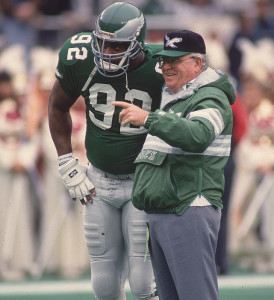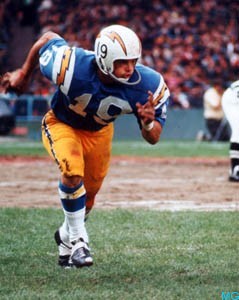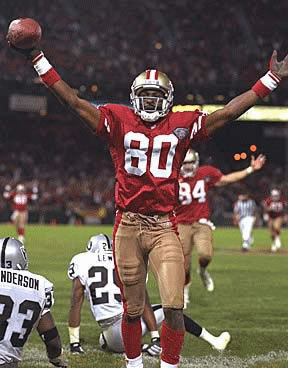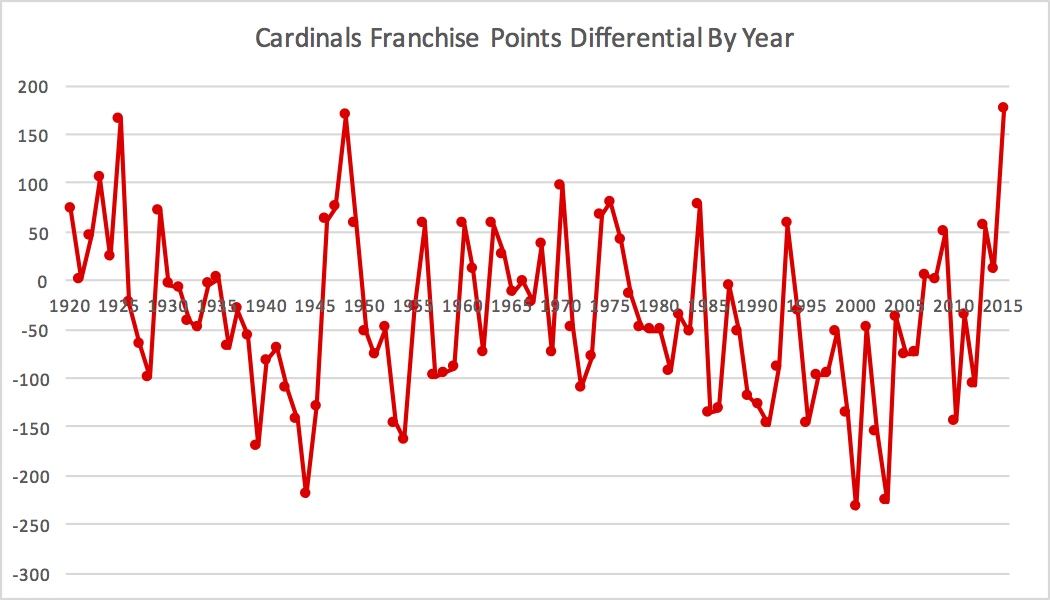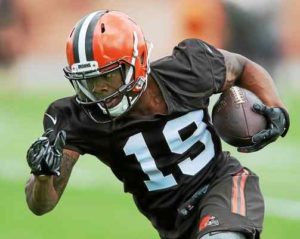Brad Oremland is a longtime commenter and a fellow football historian. Brad is also a senior NFL writer at Sports Central. He’s also a semi-regular writer here, and you can view all of Brad’s Football Perspective writing at this page. Brad is working on a WR Project where he analyzes the best WRs over various ten year periods. That work is being produced over at Sports-Central, but Brad has offered to have it reproduced here as well. As always, we at the FP community thank him for his work.
Previous Best WRs By Decade Articles:
Last year, I wrote an article breaking down the best quarterbacks by decade, followed by in-depth profiles of the greatest QBs in history. This year, I’m combining those two themes in a look at the best wide receivers ever, broken into decades. Because careers don’t always fit cleanly into a single decade, I’ve gone in five-year increments. Last week, we covered 1980-89 and 1985-94. This is the sixth installment, examining 1990-99 and 1995-2004. The great receivers of the early ’90s, such as Jerry Rice and Andre Reed, were in last week’s column.
Let’s begin with some specific categories and honors, then we’ll go in depth on the finest wide receivers of each decade.
1990-99
Fastest Receiver: Raghib Ismail
Best Deep Threat: Henry Ellard
Best Hands: Cris Carter
Best Possession Receiver: Jerry Rice
Toughest Receiver: Jerry Rice
Underrated in 2016: Herman Moore
Most Accomplished Postseason WR: Jerry Rice
Best Single Season: Jerry Rice, 1995
Best Overall WR: Jerry Rice
Raghib Ismail and his brother Qadry Ismail retired with nearly identical receiving statistics. Rocket Ismail had 363 receptions, for 5,295 yards and 28 TDs. Missile (Qadry) had 353 receptions, for 5,137 yards and 33 TDs. They each had two 1,000-yard seasons. Raghib was a more productive rusher, and Qadry a more productive returner. Raghib, projected to be the first pick in the 1991 NFL Draft, instead signed a record contract with the Toronto Argonauts, becoming a CFL All-Star before his NFL career began in 1993.
Henry Ellard, whom I named the greatest deep threat of 1985-94, remained so in the ’90s: his 17.13 average was the highest by more than a yard. Ellard had five 1,000-yard seasons in the ’90s, tied for fifth-most, behind only Jerry Rice, Tim Brown, Cris Carter, and Michael Irvin. Alvin Harper was a great deep threat across from Irvin, but never a true no. 1 receiver. Ellard had as many catches in three seasons as Harper had in his career. Irvin himself was an underrated deep receiver: he had the most 20+ yard receptions of the ’90s, and his 15.7 receiving average was highest among the 15 players with at least 500 receptions in the decade. Of note: all three of these receivers played for Norv Turner, and all created more first downs than you would expect from their reception and yardage totals.
Herman Moore was a four-time Pro Bowler and made three all-pro teams as a starter (more than Cris Carter and Tim Brown combined). Moore’s 1995 ranks among the most impressive statistical seasons of all time: 123 rec, 1686 yds, 14 TD. Looking at the 1990s as a whole, Moore had more receptions than Andre Reed, more yardage than Henry Ellard, and more touchdowns than Michael Irvin. Yes, really: Moore scored more TDs in the ’90s (59) than Michael Irvin (58). Moore had over 900 receiving yards every year from 1992-98, including three seasons of 100 receptions, but his production was largely limited to those seven seasons.
Tim Brown
Los Angeles/Oakland Raiders, 1988-2003; Tampa Bay Buccaneers, 2004
1,094 receptions, 14,934 yards, 100 TD
Although he was a first-round draft pick, Tim Brown’s receiving career began slowly. However, he was always a dazzling punt returner (3,320 yds, 10.2 avg, 3 TDs). Brown made two Pro Bowls as a returner, in 1988 and ’91, and in 2001 became the oldest NFL player (35) to return a punt for a TD. He also holds the rookie record for all-purpose yards (2,317), a record he took from Gale Sayers and has now owned for more than two decades.
Of course, Brown is most remembered as a receiver who was among the best at his position for a decade. He had nine consecutive 1,000-yard receiving seasons and ranks 5th all-time in receptions. He’s 6th all-time in receiving yards and 8th in receiving TDs. At the time of his retirement, only Jerry Rice had more yards.
I suggested last week that Andre Reed was more consistent than exceptional. The same criticism might be levelled at Brown, but less convincingly. Brown tied for the NFL lead in receptions once, never led in yards or TDs. In his 17-year career, he made the Associated Press all-pro team just once, as a second-team selection in 1997.
However, Brown, who began his career in 1988, had nine 1,000-yard receiving seasons. Reed, who began his career in 1985, had four. Brown had 1,300 yards four times. Brown had more receptions (+143), yards (+1,736), and touchdowns (+13) than Reed. He was an exceptional punt returner; Reed didn’t return kicks. Brown made nine Pro Bowls, to Reed’s seven, even though the AFC was stronger during Brown’s prime than Reed’s. They were both great players, but Brown was better.
Cris Carter
Philadelphia Eagles, 1987-89; Minnesota Vikings, 1990-2001; Miami Dolphins, 2002
1,101 receptions, 13,899 yards, 130 TD
His given name was Graduel Christopher Darin Carter. Carter grew up in southwest Ohio — Bengals country — and spelled his name “Cris” because of Bengals receiver Cris Collinsworth.
Fourth all-time in both receptions and receiving TDs, Carter joined Jerry Rice as the starting wide receivers on the 1990s NFL All-Decade team. He was selected to eight Pro Bowls and was twice named first-team all-pro. In 1994, he set the single-season record for receptions (122), and in three other seasons he led the NFL in receiving TDs. Jerry Rice, Marvin Harrison, and Carter are the only players in history with five straight years of double-digit receiving touchdowns.
I was surprised when Carter didn’t get elected to Canton in his first several years of eligibility. I suspect the voters were reluctant to enshrine him partly for the same reason Art Monk had to wait so long. Monk was repeatedly dismissed as a guy who caught 900 eight-yard hooks, and who wasn’t the most dangerous receiver on his own team. Carter averaged just 12.6 yards per reception, one of the lowest marks in history for an elite wide receiver. Defenses fear the deep threat, the guy who can burn you on any given play. For Washington in the ’80s and early ’90s, that was Gary Clark, not Monk. For Minnesota, it was Randy Moss, not Carter.
Carter last led the Vikings in receiving yards in 1995. Thereafter, he was outgained every year by either Jake Reed or Moss. And yet, half his production came after ’95: five of his eight 1,000-yard seasons, four of his six double-digit TD years, overall about 50% of his statistical value. Essentially, Carter battled the notion that he usually wasn’t the best receiver on his own team, that he was a system player who caught a bunch of short passes and seldom had to deal with double-teams. He was reliable more than explosive, and he was tough like Monk, not graceful like Lance Alworth or Lynn Swann. Carter just doesn’t have the highlight reel those guys do, and he never won a championship.
Of course, that doesn’t mean Carter’s highlight reel is empty. Anyone who watched football in the ’90s remembers, “Cris Carter. All he does is catch touchdowns.” Although made famous by Chris Berman, the phrase originated with Carter’s coach with the Eagles, Buddy Ryan, and was not entirely a compliment. Carter’s most famous highlight came in college. Playing in the Citrus Bowl for Ohio State, Carter caught a ball that his quarterback had tried to throw away.
Carter is one of the most improbable winners ever of the Walter Payton Man of the Year Award. Carter was cut by the Eagles because of drug, alcohol, and personal issues. He antagonized teammates in Minnesota; when Carter was elected to the Hall of Fame, former teammate (1993-96) Qadry Ismail told Sirius XM, “Cris was a bona fide diva … extreme selfishness.” In The Best Minnesota Sports Arguments, Carter has his own chapter entitled, “What Was the Most Selfish Act Committed by a Minnesota Athlete?” The story involves Vikings running back Bill Brown and his dying wife, and paints a very ugly picture of Carter — when he was sober, and old enough to know better. At the 2014 NFL rookie symposium, Carter advised young players that if they got into trouble, “You’ve got to have a fall guy in the crew,” to take the blame. Cris Carter was a great receiver, but he doesn’t seem like a good person.
Irving Fryar
New England Patriots, 1984-92; Miami Dolphins, 1993-95; Phildaelphia Eagles, 1996-98; Washington, 1999-2000
851 receptions, 12,785 yards, 84 TD
Irving Fryar was a late bloomer. The first overall pick in the 1984 draft, Fryar quickly made his mark on special teams — he was a Pro Bowl returner, with 3 punt return TDs in his first three seasons — but didn’t emerge as a major receiving threat until he left New England to play for the Dolphins and Eagles. His first 1,000-yard season came in 1991, when Fryar was 29 and playing his eighth year in the NFL. He was 31 when he made his first Pro Bowl as a receiver, a 10-year veteran. His career-high 1,316 receiving yards came at age 35.
Fryar made five Pro Bowls (one as a returner) and was second-team all-pro twice (once as a returner). He had five 1,000-yard seasons, and his accomplishments as a returner are significant. It’s natural, I think, to compare him to Henry Ellard. They were drafted just one year apart, both were great punt returners early in their careers, both had most of their best seasons in the ’90s, both had career numbers that looked exceptional when they retired, and far less impressive since the explosion of receiving stats in the expansion era.
Choosing between the two, I’d go with Ellard. He had more good seasons, more of his production came before league-wide receiving numbers went through the roof, and he had a stronger peak. Ellard had four seasons among the top four in receiving yards, Fryar none. Ellard played against tough NFC competition, in an era when the AFC was a substantially weaker conference. They were both great players, but Ellard was more exceptional.
Since I spent a paragraph explaining why I’m not wild about Cris Carter, for the sake of equal treatment I should point out that Irving Fryar has an even uglier past. He missed the 1985 AFC Championship Game due to an injured hand. But he didn’t hurt the hand playing football, he hurt it in a domestic dispute with his pregnant wife (Fryar needed six stitches). He had drug issues, violence against women and animals, allegations that he attempted to throw a game in college. He was arrested on weapons charges. Rick Reilly called Fryar “the All Pro screw-up, the Human Incident, the Original Sinner.” Fryar is currently in jail for fraud.
Michael Irvin
Dallas Cowboys, 1988-99
750 receptions, 11,904 yards, 65 TD
I named Jerry Rice’s 1995 season the greatest by a wide receiver in the 1990s. That’s tough to argue with. Rice caught 122 passes, for 1,848 yards and 15 TDs. Those are excellent totals, in every category, and his single-season yardage record lasted almost 20 years. But there’s a compelling argument to be made that in 1991, Michael Irvin was even better. Irvin caught 93 passes, for 1,523 yards and 8 TDs. Those are great stats, but they’re dwarfed by Rice’s. What’s the argument for Irvin?
First, consider that Irvin’s 93 receptions produced 79 first downs, compared to 75 first downs for Rice. That 122-93 reception gap is a lot less significant when you consider what their catches did for the team. We also need to consider the environment of the league. Passing statistics exploded in the mid-1990s, and 1995 was an expansion year, diluting the talent pool and allowing the best players to excel even more than usual. In 1995, Rice had 67 yards more than 2nd-place Herman Moore. In 1991, Irvin had 187 yards more than 2nd-place Gary Clark. Irvin had the most receiving first downs in the NFL, by 17. Four receivers had more first downs in 1995 than Rice. While Rice’s raw numbers are much better, Irvin actually stood out more from the league. And it wasn’t a one-year blip. Irvin had more yards and more first downs in 1991 than any receiver the two years before and after.
1991 was the only season in which Irvin led the NFL in a major statistic. In 1995, he had more catches (111) for more yards (1603) and more TDs (10), but in context, ’91 was a better season. Irvin retired with seven 1,000-yard seasons, plus 962 in an injury-shortened (11 games) 1996. In four of those years, Irvin gained over 1,300 yards. He was big for that era, and strong and fast.
He was also a great postseason performer. In 16 postseason games, Irvin caught 87 passes for 1,315 yards and 8 TDs. He had six 100-yard games, plus four more with over 80 yards. That includes 114 yards and 2 TDs in Super Bowl XXVII, one of three Super Bowl victories in Irvin’s career.
Andre Rison
Indianapolis Colts, 1989; Atlanta Falcons, 1990-94; Cleveland Browns, 1995; Jacksonville Jaguars, 1996; Green Bay Packers, 1996; Kansas City Chiefs, 1997-99; Oakland Raiders, 2000
743 receptions, 10,205 yards, 84 TD
Andre Rison played for seven NFL teams. A guy’s career looks fragmented when he moves around so often, hard to view as a whole. Irving Fryar and Rison did a lot of the same things as Andre Reed, but the constant team-switching makes it hard, psychologically, to view them that way. During his NFL career, Rison caught touchdown passes from Jack Trudeau (4), Chris Miller (25), Scott Campbell (2), Billy Joe Tolliver (6), Wade Wilson (3), Bobby Hebert (11), Jeff George (9), Vinny Testaverde (1), Eric Zeier (2), Mark Brunell (2), Brett Favre (1), Elvis Grbac (7), and Rich Gannon (11).
Part of the reason Rison moved around so much is that he was viewed as a bit of a headcase. He was a showboat in Atlanta, but you can get away with that when you’re performing at a high level. Rison signed a big free agent contract with the Browns, then publicly cursed at the Cleveland fans. He played for five teams in four years, his girlfriend alleged that he was abusive , he went to the Raiders — of course he went to the Raiders — and Rison even played for the Toronto Argonauts after his NFL career ended (winning a Grey Cup in 2004).
What if Rison had stayed with Atlanta, or gone to a stable team rather than one on the eve of a move to Baltimore? He was a Pro Bowler for the Chiefs in 1997, and a valuable player for the Packers in the 1996 postseason, including a 54-yard TD reception to begin Super Bowl XXXI, so it’s not like his talent dried up after he left Atlanta, or that he couldn’t succeed without the run and shoot. But that was the widespread impression at the time; Rison’s success with Green Bay was a real surprise coming from someone most fans thought was finished as an impact player.
A first-team all-pro in 1990 and a five-time Pro Bowler, Rison had five 1,000-yard seasons and in 1993 tied Jerry Rice for the most receiving TDs in the NFL (15). In his final NFL season, Rison became just the seventh player in history with 700 receptions, 10,000 yards, and 80 touchdowns. NFL players with four consecutive seasons of double-digit receiving TDs: Tommy McDonald, Bob Hayes, Jerry Rice, Rison, Cris Carter, Randy Moss, and Marvin Harrison.
1995-2004
Fastest Receiver: Randy Moss
Best Deep Threat: Randy Moss
Best Hands: Marvin Harrison
Best Possession Receiver: Marvin Harrison
Toughest Receiver: Keyshawn Johnson
Underrated in 2016: Jimmy Smith
Most Accomplished Postseason WR: Rod Smith
Best Single Season: Jerry Rice, 1995
Best Overall WR: Marvin Harrison
Randy Moss was as fast as anyone. If there’s anyone else from this era who compares, it would surely be Tim Dwight. I explained last week that given a close call between two players for a designation like “Fastest Receiver”, I prefer to highlight the lesser-known. Within that, however, I still want to recognize legitimate football players, not just fast guys who put on pads and a helmet. Tim Dwight was a real football player, but he was a returner more than a receiver. Dwight had 203 kickoff returns, 185 punt returns, and 194 career receptions.
The 8th pick in the 1995 NFL Draft, Joey Galloway was a downfield receiver, a burner. He scored 5 punt return TDs and rushed for 496 yards, one of the highest totals ever by a receiver. He had six 1,000-yard receiving seasons and three years of double-digit TDs, retiring with 83 total TDs and nearly 11,000 receiving yards. He never made a Pro Bowl, but he was a good player with a 16-year career.
Galloway is statistically comparable to Keyshawn Johnson, Keenan McCardell, Muhsin Muhammad, and Rod Smith (see below). McCardell quietly caught almost 900 passes and gained over 11,000 yards. A two-time Pro Bowler, he had five 1,000-yard seasons and five years among the NFL’s top 10 in receptions. A 12th-round draft pick in 1991, McCardell didn’t get a chance to play regularly until he joined the Jaguars in 1996. If McCardell hadn’t lost five years of his prime sitting on the bench, would he be a Hall of Famer? Maybe.
One of the more underappreciated receivers in recent history, Muhsin Muhammad gained at least 500 receiving yards in 12 seasons, caught 90 or more passes three times, and led the NFL at various times in every major receiving category: receptions (2000), receiving yards (2004), and receiving touchdowns (2004). He made two Pro Bowls and was first-team all-pro in ’04.
Isaac Bruce
Los Angeles/St. Louis Rams, 1994-2007; San Francisco 49ers, 2008-09
1,024 receptions, 15,208 yards, 91 TD
Isaac Bruce ranks 4th all-time in receiving yards. He had eight 1,000-yard seasons, including 1,781 in 1995, still the 5th-highest total in history. Bruce was hard-working, humble, and well-liked. He was a good route-runner, and he was fast enough to worry defenders, but he had the hands of a great possession receiver. Bruce spent much of his career on bad teams, but made big plays when he got the chance, including the 73-yard game-winning touchdown in Super Bowl XXXIV.
Bruce was named to four Pro Bowls and went over 1,000 yards four other times, including 1,292 in 2004 and 1,781 in 1995. His résumé bears a similarity to Charlie Joiner’s — guys with long careers and sensational counting stats, but who weren’t usually regarded as being among the very best while they were active. Both also have to fight the perception that their numbers are partly or largely a product of the absurd offenses they played in, where any receiver could become a star.
Bruce’s case is a little stronger than Joiner’s. He ranked in the top five in receiving yards four times (and led the league in 1996), compared to only twice for Joiner, who never led the NFL in a major statistic. Two of Bruce’s three best seasons came when the Rams were coached by Rich Brooks, while Joiner’s best years were under Don Coryell. Bruce had four 100-yard games in the postseason, and he was a Super Bowl star. Joiner deserves his place in Canton, and Bruce deserves to join him.
Marvin Harrison
Indianapolis Colts, 1996-2008
1,102 receptions, 14,580 yards, 128 TD
In eight consecutive seasons, Marvin Harrison finished with more than 80 receptions, 1,100 yards, and double-digit touchdowns. He is the only player in history with four consecutive 1,400-yard seasons, and one of only five (Jerry Rice, Randy Moss, Larry Fitzgerald, Andre Johnson) to go over 1,400 in any four seasons. Harrison still holds the single-season record for receptions (143). He led the NFL twice in receptions, twice in receiving yards, and once in receiving TDs. He was first-team all-pro three times and qualified for eight Pro Bowls.
Harrison was not the biggest, fastest, or strongest receiver in the game; he didn’t intimidate opponents the way Terrell Owens and Moss did. But Harrison was one of the smartest receivers ever to play, and like Rice, he worked very hard to be the best; the extra practice hours he put in working with Peyton Manning are legendary. Harrison was an exceptional route-runner, and he was the best I ever saw at the toe-tap on the sideline. Give him an inch and he’d make the catch.
Harrison, Rice, and Andre Johnson are the only players with three 1,500-yard receiving seasons. Harrison has the most receptions, receiving yards, and TDs of any player to spend his whole career with one team.
Keyshawn Johnson
New York Jets, 1996-99; Tampa Bay Buccaneers, 2000-03; Dallas Cowboys, 2004-05; Carolina Panthers, 2006
804 receptions, 10,571 yards, 64 TD
The top pick in the 1996 draft, Keyshawn Johnson was known as much for his attitude as his play. He caught 70 or more passes nine times, and wrote a book (with Shelley Smith) titled Just Give Me the Damn Ball!, setting the tone for a parade of diva receivers ever since. He had at least 600 receiving yards every year of his career, and he was dismissed from the Buccaneers in mid-season 2003 because the defending champs didn’t want to deal with him any more. His name is Joseph Ladarious Keyshawn Johnson, and he was nicknamed Me-Shawn.
Some people won’t like that I named Johnson the toughest receiver of the decade. Keyshawn was a self-centered loudmouth, arguably the first of the modern diva receivers. But he was also a gritty possession receiver who would go over the middle, and he was the best blocking WR of his generation. If he had been 10 or 15 pounds bigger, Johnson would have been a Shannon Sharpe-style tight end. He made three Pro Bowls, caught 100 passes one year, and retired with more than 800 receptions, for over 10,000 yards.
The famous 1996 receiver class includes Marvin Harrison, Terrell Owens, Keyshawn Johnson, Muhsin Muhammad, Eric Moulds, Joe Horn, Amani Toomer, Terry Glenn, Eddie Kennison, and Bobby Engram. All 10 had over 500 receptions, over 7,500 receiving yards, and at least 35 touchdowns. Seven of the 10 made at least one Pro Bowl, and they combined for 27. Taken as a group, they averaged 768 catches, 10,568 yards, and 69 TDs — about the same numbers as Keyshawn. I’d be surprised if there’s ever another class of rookie receivers so deep and successful.
Jimmy Smith
Dallas Cowboys, 1992-93; Jacksonville Jaguars, 1995-2005
862 receptions, 12,287 yards, 67 TD
You probably don’t remember Jimmy Smith on the Super Bowl-winning Cowboys in 1992. He played seven games and never caught a pass. He didn’t play at all the next two years. Smith didn’t become a full-time starter until 1996, when he was 27, an age when many players begin to decline.
Smith made the most of the years he did play, with nine 1,000-yard receiving seasons and five Pro Bowl appearances. Smith was only the third player with multiple seasons catching 110 or more passes, the first two being Jerry Rice and Cris Carter from 1994-95. He is one of only five receivers with nine or more 1,000-yard seasons (Tim Brown, Randy Moss, Terrell Owens, Rice), and one of six with six straight 1,100-yard seasons (Marvin Harrison, Torry Holt, Moss, Rice, Roddy White). In 1999, Smith led the NFL in receptions (116) and first downs (86), then the highest totals in history outside the whacked ’94-’95 seasons, and his team went 14-2.
Smith was occasionally dogged by drug issues, and his four-game suspension in 2003 probably kept him from becoming the only person besides Rice with 10 straight 1,000-yard seasons. Smith left the game when he was still a good player; his final season yielded 70 catches, 1023 yards, and 6 TDs. Smith in 2004 gained the third-most receiving yards ever by a 35-year-old (1,172), and he and Rice are the only players ever to gain over 1,000 yards in a full season after turning 36.
So in Smith you have one of the best old receivers ever, a guy who had a lot of good seasons, including five years over 1,200 yards and two seasons catching more than 110 passes. His detractors would point out that while Smith did have exceptional years, and played well in several others, he had so few seasons on the field that his overall statistics don’t measure up to the best players of his generation. Some detractors would also mention the drug thing, but unlike some of the other players profiled here, Jimmy Smith really wasn’t a bad guy. He was an addict, but he wasn’t a jerk.
Most 1,000-yard receiving seasons in NFL history:
1. Jerry Rice, 14
2. Randy Moss, 10
t3. Tim Brown, 9
t3. Terrell Owens, 9
t3. Jimmy Smith, 9
Rod Smith
Denver Broncos, 1995-2006
849 receptions, 11,389 yards, 68 TD
Keenan McCardell, Muhsin Muhammad, and Rod Smith have virtually identical career stats:
Rec Yards 1stD TD
Muhammad 860 11,438 566 62
Smith 849 11,389 570 68
McCardell 883 11,373 568 63
It’s remarkable for three contemporary players to post such similar stats over long, productive careers. Overall numbers notwithstanding, Smith was by far the best of the three. He had eight 1,000-yard seasons, as many as McCardell (5) and Muhammad (3) combined. Smith played on two Super Bowl champions, with 152 yards and a touchdown in Super Bowl XXXIII. He caught 100 passes twice, caught 70 passes nine times, double-digit TDs twice, 1,200 yards three times, as many as 1,600 one year.
Smith didn’t have a long career. Undrafted out of Division II Missouri Southern, he didn’t play in the NFL until he was 25, and didn’t become a starter until he was 27. It’s a shame careers can turn so heavily on high school performance. If Smith had been offered a scholarship to a Big 10 or SEC school, gotten drafted in the third round, and become a starter when he was 23 or 24, maybe he’d have another 200 receptions, 3,000 yards, 20 TDs.
We could also throw Keyshawn Johnson into the McCardell-Muhammad-Smith group. His stats are basically the same: 800-900 receptions, about 11,000 yards, 60-70 TDs. Shannon Sharpe’s statistics are similar to Keyshawn’s, if you exclude first downs.
Rec Yards 1stD TD
Muhammad 860 11,438 566 62
Smith 849 11,389 570 68
McCardell 883 11,373 568 63
Johnson 804 10,571 552 64
Sharpe 815 10,060 490 62
Other players with comparable stats include Gary Clark, Donald Driver, Joey Galloway, Michael Irvin, Chad Johnson, Santana Moss, and Brandon Marshall (through 2015), although all except Marshall had fewer receptions.

